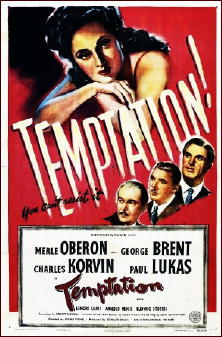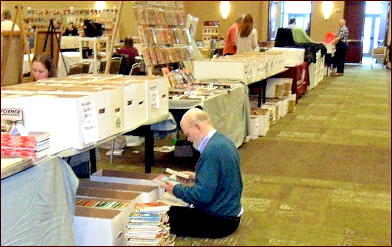May 2013
Monthly Archive
Fri 10 May 2013
REVIEWED BY DAN STUMPF:
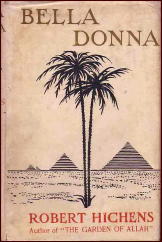
BELLA DONNA. Twickenham Studios, UK, 1934. Mary Ellis, John Stuart, Nigel Armine, Cedric Hardwicke, Conrad Veidt, Jeanne Stuart. Based on a novel by Robert Hichens. Director: Robert Milton.
TEMPTATION. Universal Pictures, 1946. Merle Oberon, George Brent, Charles Korvin, Paul Lukas, Lenore Ulric, Arnold Moss. Based on a novel by Robert Hichens. Director: Irving Pichel.
Bella Donna is one of those unique little films that will stay on my mind long after better-known flicks have gone their way. Based on a novel by Robert Hitchens and a play by James B. Fagan, it weaves, rather than tells, the story of a divorcee apparently used to using men and using them up, who marries a chump and goes with him to Egypt where he’s apparently some sort of busy muckety-muck with a job that entails long separations.
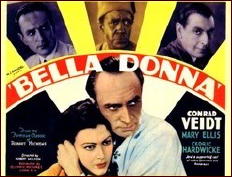
Bored and horny, she falls under the spell of a sinister Egyptian — himself something of a rat with women — and finds herself hopelessly addicted to his charms. So much so that when he expresses annoyance at her husband’s infrequent presence, she decides on divorce-by-poison, with intriguing consequences.
This story is put across in a series of rather stagey confrontations — the plot is developed and moved around by long scenes of dialogue rather than action — but this in no way diminishes the charms of a film whose chief allure is in mood and atmosphere. Bella Donna starts out as a very properly British sort of thing, with smoking jackets, drawing rooms, and a nearly palpable sense of Stuffie Olde Englande, furthered by the playing of Mary Ellis as the divorcee, John Stuart as the chump, and especially Sir Cedric Hardwicke as the chump’s wise doctor-friend, looking ruefully on as his old chum hastens to ruin.
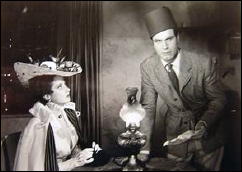
Once the couple leaves England, though, we get an equally visceral sense of Egypt as some eerie fairyland, a kingdom suffused with dread and desire in equal measure. Conrad Veidt turns in a magnetic performance as the sinister Egyptian (despite the fact that his makeup keeps changing from pale Eurasian to something resembling a minstrel show) stalking through sets of literally byzantine splendor, and director Robert Milton maintains a slow but insistent pace, like the music of a snake-charmer, as the story plays itself out to a conclusion I will probably never forget. The last shot of Bella Donna is one of those rare cinematic codas, like the last shot of Vertigo, The Searchers or Shock Corridor, that says much more than words ever will, and one that’s a lot of fun to get to.
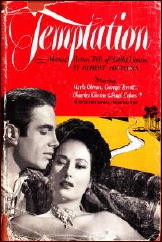
The story was remade in Hollywood in 1946 as Temptation, directed by Irving Pichel, with Merle Oberon as the femme-would-be-fatale, who marries George Brent over the objections of Paul Lukas and subsequently falls for Charles Korvin. Temptation seems to have set the pattern for subsequent Victorian noir films like Ivy (1947) and So Evil My Love (1948) but it also shows the sad censorial effects of its time:
Where the Mary Ellis in the earlier film seemed warped by lust, Merle Oberon is merely enslaved by passion. Poisoning the chump becomes her lover’s idea, not her own, and both lover and erring wife must come to some explicitly sticky end. And I mean sticky. The writers apparently got themselves into a corner on this one, deciding that a big star like Merle Oberon had to meet her own fate (rather than get picked up by the cops) but Suicide as a plot resolution was not permitted in films then.
The result is a rather muddled off-screen affair recounted by Lukas to an unbelieving cop (nicely played by Arnold Moss, usually a heavy in the movies, and a very good one). There is, however, a rather nice wrap-up, and the rest of the film is done with enough grace and Hollywood polish to make it a pleasant 98-minute trip.
Thu 9 May 2013
MAX BRAND – The Phantom Spy. Pocket, reprint paperback, December 1975. Dodd Mean, hardcover, 1973. First serialized in Argosy magazine, as “War for Sale,†April 24 to May 15, 1937.

They don’t write spy novels like this any more, and even when they did, I have a feeling that it was only Max Brand who wrote them. He had a highly romanticized view of the world, one in which friends were friends, lovers were lovers, and enemies were enemies, and even on occasion when there was some well-constructed confusion as to which was which, the reader always knew.
Lady Cecil de Winter is the early star of this one, a delightful young lady with a real feel for the game of espionage. Recruited by the British government in those days immediately prior to World War II to retrieve missing plans for the Maginot Line – a grand line of defense designed to protect France and Western Europe on the chance that war should break out — she recruits in turn a fellow named Willie Gloster, a cheerful, happy-go-lucky American who provides the help she needs, only to have her lose them again (the plans, that is) to the hands of a suave but evil mastermind by the name of von Emsdorf.
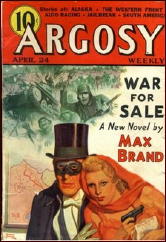
And the game is on. Not since reading the adventures of the early Saint have I read a tale of down to earth swashbuckling, without a single swash or buckle in sight. There is, of course, a phantom spy, a chap named Jacquelin, whom Lady Cecil believes to be another fellow named Cailland. We know better, and we groan in despair when she leaves the love of her life, Willie Gloster, who comes to her aid again anyway.
There is blood, there is danger, and there is one hell of a grand impersonation, and there is more. This is the real stuff, but written well before we know how far Hitler would go and how the war would really be waged. Max Brand, who of course is much better known for his westerns, was well aware of what causes countries to wage war with one another, but only close to the end of this book does he let the details intrude, and truth be told, I’d’ve rather he hadn’t.
This is very much of a period piece, if you haven’t gathered that already, but as I suggested at the beginning, perhaps it was even at the time it was written.
Wed 8 May 2013
COLLECTING PULPS: A MEMOIR, PART EIGHT —
THE NIGHT PULPCON ALMOST ENDED WITH A DRUNKEN BRAWL
by Walker Martin
I guess if you live long enough and hang out in the appropriate dives, you will eventually see fistfights and guys swinging beer bottles at each other. Normally you will not see book or pulp collectors try to strike and harm another collector. I’ve always said my favorite type of people are book collectors and since there are so few pulp collectors left, I don’t want to get into any arguments with the few that are still around.
Today, a friend sent me an email about a British first edition by H. Bedford Jones. He mentioned that he might consult the resident H. Bedford Jones expert, Digges La Touche (see above). Upon reading this, I almost fell out of my chair laughing and yelling “So you’re the expert on H. Bedford Jones!” I was thinking back more than thirty years ago when the Pulpcon convention almost ended in a drunken brawl.
Rusty Hevelin, the head honcho and boss of the convention, never scheduled the evening panels ahead of time. He just about always would give you an hour or even a few minutes notice that he would like you to talk about a pulp author or be part of a panel discussing some aspect of pulpish literature.
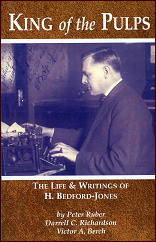
I remember once he approached me about ten minutes before the start of the evening programming and wanted me to interview Robert Bloch. Sometimes I turned him down due to not being prepared on short notice but other times I accepted.
Evidently, at the last minute, Rusty decided to have a panel discuss H. Bedford Jones. He found three collectors who agreed and up to the stage stepped veteran pulp collectors Darrell Richardson, Harry Noble, and Digges La Touche. All were fans of the author and the discussion kept everyone’s attention.
Everyone behaved themselves and there was no problem. Until the banquet that night. Harry Noble and I were sitting at one of the dinner tables waiting for our food and drinking beer. Another long time pulp collector, Andy Biegel, also sat down. Without any preface or explanation, Andy blurted out, “So you’re the expert on H. Bedford Jones.” At first Harry and I thought that he was kidding and we just laughed. Andy didn’t laugh however and he repeated in a louder voice, “So you’re the expert on H. Bedford Jones.”
We now realized that Andy Biegel was drunker that we were and was in fact insanely jealous because he had not been chosen to be on the Bedford Jones panel. Harry tried to explain that he was not an expert but just a fan of the writer and loved to talk about his books. Andy was having none of it and repeated for the third time, at the top of his voice, “SO YOU’RE THE EXPERT ON H. BEDFORD JONES!”
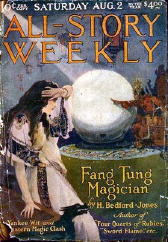
At this point it was obvious that in another minute Biegel was going to fling himself across the table and try to strangle Harry Noble. Though Harry was older than Biegel, such an action would not be a good idea since Harry was a fitness buff and body builder. Since I considered Harry my best pal, I certainly would have joined in the fight and probably we all three would have been rolling over on the floor punching and flailing.
To make things worse, Andy had a disability involving one leg being shorter than the other. I’m sure Harry and I would have been banned from Pulpcon for life for the drunken beating of a person with a physical handicap. So fortunately we stood up and without saying a word to Andy, we left the room. The next day Andy Biegel evidently didn’t remember anything about the incident and talked to us just as though nothing had happened.
Harry Noble and Andy Biegel are no longer with us but I still remember the Pulpcon brawl that almost happened over 30 years ago. Everytime I hear that someone is an expert on H. Bedford Jones, I start to scream, “So you’re the expert on H. Bedford Jones!”
Fri 3 May 2013
The weather has been nice all week, but I’ve been ill, and I haven’t had much time to enjoy it. I’ve managed to get a couple of reviews and articles posted, but that’s been it. Now that I’ve started to get my legs back again, my wireless network connection, which has been iffy all spring, has gone completely kerflooey. I may have to scrap everything, router, adapter, extender, and start over, and at the moment, I’m not up to it. Without the use of a thumb drive to transfer data from one spot to another, there are too many programs on my upstairs computer that I can’t access from down here on my laptop. It might be time to call in the professionals.
I may not take a solid break, but it sure sounds to me as though it’s time to cut back on blogging until I get everything under control again. (I might even start getting caught up on emails, a task I’ve been promising myself since ever so long, longer than I care to admit.)
Thu 2 May 2013
Posted by Steve under
Reviews[6] Comments
Josef Hoffmann:
Two Crime Novels by RYERSON JOHNSON
Ryerson Johnson (1901-1995) is known primarily as an author of Westerns, but he also wrote numerous crime novels. Only two were published in his own name:
Naked in the Streets, Red Seal #10, Fawcett, 1952, cover art Carl Bobertz.
Lady in Dread, Gold Medal #459, Fawcett, 1955, cover art Barye Phillips.
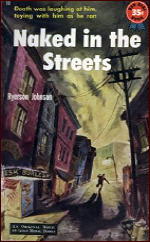
Naked in the Streets begins like a noir novel. Herbert Hopson is employed in a company that manufactures perfume. On the way to work he is knocked from the sidewalk into the street by an unknown passerby and almost run over. He cannot believe that this happened intentionally. As he suffered a minor injury and tore his clothing in the fall, he returns home to change clothes.
A strange scene awaits him in his apartment. In the half-light his wife, Sybil, sits on a chair as if on a throne in an almost naked state, with a dog whip in her hand and stilettos on her feet. She is enraged at her husband because he has returned home unannounced. She explains the strange scene by claiming that she will be appearing at a charity bazaar as an animal trainer.
Hopson goes back to work wearing fresh clothes. There he behaves in such a provocative manner that he is fired instantly. He goes to a strip club to see Sally Dawn, whom he worships, stripping. During this time, a man seated in the seat in which Hopson should have been sitting is murdered. Hopson flees from the club and later returns to his apartment.
In an argument with Sybil he rips the clothes from her body, while she scratches his face. Whereas Hopson is ashamed, his wife is turned on by the violent behaviour and wants him to punish her with the whip. Her husband is disgusted and leaves the apartment in a state of shock. When he returns shortly afterwards in order to talk things through with her, she is dead, strangled.
Hopson fears that the police will not believe in his innocence, which is why he does not call them. He suspects that the murder is somehow connected to his wife’s double life. In the apartment he catches the scent of a perfume produced by his company that is still in the testing phase and which has not yet been released to the market.
For this reason Hopson suspects that someone from the company is involved in the murder plan. He sets off to find the suspects and to reveal the real murderers. In the process he is hunted by both the murderers and the police. He ends up in turbulent scenes, but he constantly finds people who trust him and help him. The story naturally includes a prostitute, who falls in love spontaneously with our hero and provides him with an alibi. And then of course there is also the mysterious Sally Dawn.
Although the story of Naked in the Streets is at times unrealistic and kitschy, the action is very varied and the dramaturgy of suspense is well done.
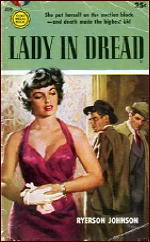
Already after reading the first two pages of Lady in Dread we know that the author has very clear ideas of Good and Evil, and where his position is in relation to each. The novel is set in Coalfield, a city to the south of Chicago, which has been dominated by gambling and crime since the decline of the coal-mining industry.
Tessie Cullen, a beautiful young woman, applies for a job as a “twenty-six girl†at a dice table in Farmer McGivern’s Top Money Tavern, and gets it. Farmer McGivern is one of the rulers of the city. A scene takes place every day at around the same time, opposite his gambling saloon, upon which the spectators place bets. A hawk sits on the flagpole of the courthouse and watches sparrows. Then, suddenly, it pounces on one of the sparrows and takes it as its prey. The spectators bet on the time of day at which the hawk carries out this act.
Hally Harper, a good-looking young lawyer, comes to Coalfield on behalf of an animal welfare organisation, in order to combat the betting spectacle. In reality, however, he is a narcotics officer pursuing a truckload of opium. The opium belongs to a Chicago gangster syndicate and was stolen in the vicinity of Coalfield. The syndicate has a premises in Coalfield, a glamorous nightclub with a casino at the city limits. It is trying to extend its influence over the city. The syndicate gets Tessie Cullen to spy on the Farmer, especially to see if he has claimed the opium.
There is yet a third party that also rules over Coalfield, the mayor. Which of the three parties has got hold of the opium delivery? Or is it a fourth, unknown entity? Harper tries to find out by questioning different people and searching for possible hiding places. In the process he whips up a storm and frequently ends up in danger of his life.
Tessie Cullen, who first tries to trap Harper on behalf of the Farmer, later joins his side. She asks Harper how he can be so ambivalent in the face of impending death.
The novel is varied and full of action, albeit rather conventional. A particular moment of tension is created by the fact that, while the hero and heroine act in a covert manner and are thus forced into falsifications and lies, they nevertheless try to maintain the core of their moral identity, in other words, to remain true to themselves. The narrative style tends towards hard-boiled, but not to noir fiction, as the protagonists are not subject to any calamitous fate. I always had a good feeling while reading the novel.
— Translated by Carolyn Kelly
« Previous Page




